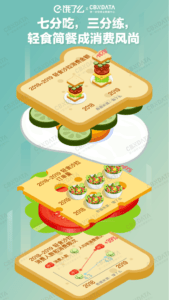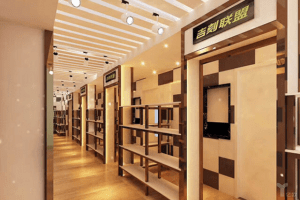 As Farrer mentioned in Food and Cities, life in the Asian city is increasingly organized by regimens of body discipline, often centering on dieting and weight control. While some food could be the vehicle for conveying urban nostalgia, salad could be a vehicle that convey a sense of modern, health and fitness. Fitness became the new faith of the modern cities and salad became a kind of panacea for people to lose weight and gain fitness. The increasing need for salad ignites a boom in salad restaurants because lots of people want to make money by selling salad. We could see the data from Eleme app that the sales of salad in 2019 were 61% higher than in 2018. However, it is hard for those who want to succeed in this salad sales competition. As a consumer, I have found that lots of salad stores disappear from the list of food delivery apps and lots of new salad stores appear.
As Farrer mentioned in Food and Cities, life in the Asian city is increasingly organized by regimens of body discipline, often centering on dieting and weight control. While some food could be the vehicle for conveying urban nostalgia, salad could be a vehicle that convey a sense of modern, health and fitness. Fitness became the new faith of the modern cities and salad became a kind of panacea for people to lose weight and gain fitness. The increasing need for salad ignites a boom in salad restaurants because lots of people want to make money by selling salad. We could see the data from Eleme app that the sales of salad in 2019 were 61% higher than in 2018. However, it is hard for those who want to succeed in this salad sales competition. As a consumer, I have found that lots of salad stores disappear from the list of food delivery apps and lots of new salad stores appear.
According to the China Hotel Association, the average gross profit of the surveyed catering enterprises is 49.22%. The gross profit of a bowl of salad could reach up to 60%-80%. Why lots of those salad shops failed to survive?
First of all, raw material is a problem. In Fabio’s book, Food, he mentioned that because of the intricacy of supply networks, sometimes the consumers would not understand why the price of those goods is high. Salad shops owners have to balance the cost and the quality of the raw material. The freshness and safety requirements are very high when making salad and solving the supply chain is the most critical issue. The owners would have to pick the right source such as a stable supplier to produce clean vegetables, cold chain delivery to the store, or their own vegetable base resources. This would usually increase the cost. Additionally, how to keep the material fresh during the delivery to the customers is also a problem, because people are becoming pickier on food safety.
 Secondly, the cost of renting could also bother those salad shop owners. Because of the development of online food delivery apps, lots of the physical stores could not compete with those salad shops based online who use small shared kitchen rental service to reduce rent. An in-store salad shop is much more expensive, risky and less efficient than a take-out shop, because of the higher rent and more salaries paid for the waiter/waitress. However, because of the lack of regulation, salad made in those small shared kitchens have no quality assurance. Lots of apps had to compulsorily shut down those shops that did not meet the health requirements to prevent food poisoning.
Secondly, the cost of renting could also bother those salad shop owners. Because of the development of online food delivery apps, lots of the physical stores could not compete with those salad shops based online who use small shared kitchen rental service to reduce rent. An in-store salad shop is much more expensive, risky and less efficient than a take-out shop, because of the higher rent and more salaries paid for the waiter/waitress. However, because of the lack of regulation, salad made in those small shared kitchens have no quality assurance. Lots of apps had to compulsorily shut down those shops that did not meet the health requirements to prevent food poisoning.
In conclusion, though the salad could be a relatively low-cost food for people to make money, it is cruel to find that only people who hold capital and stable supply chains could success in this field. In fact, the shops that are successful now mostly have both online and offline shops to extend their service and have famous brands. This is because they have entered this business earlier to have lower rent and more options of material resources. The food delivery apps could not be the savior of people with little capital like those migrant workers.
Leave a Reply